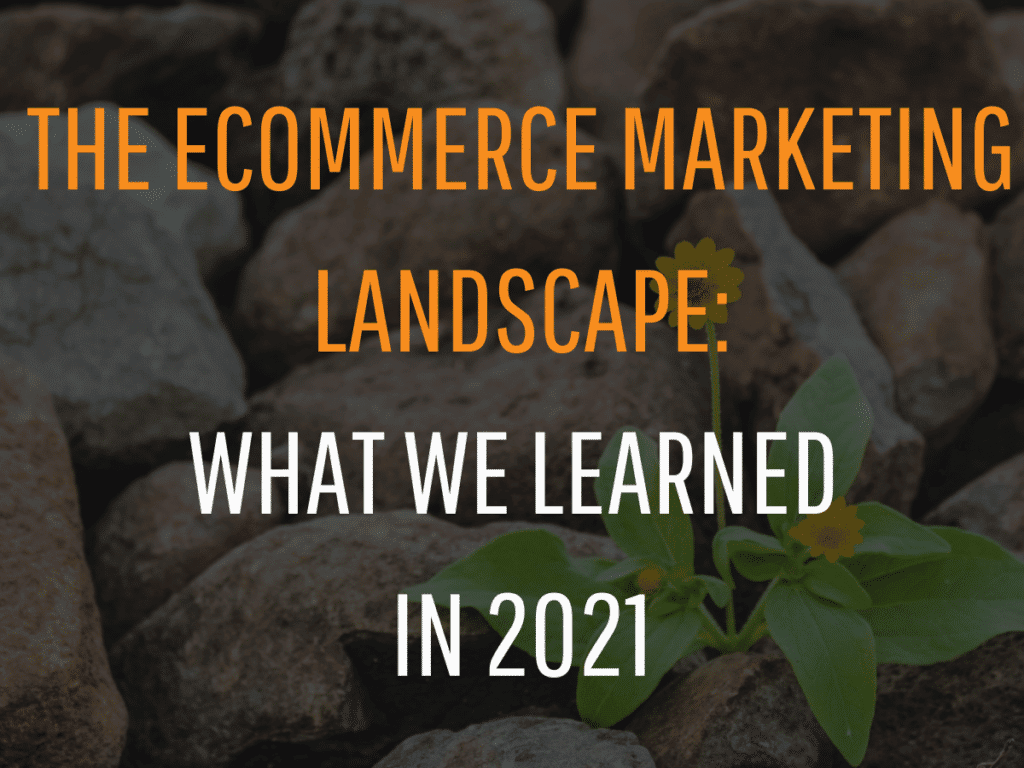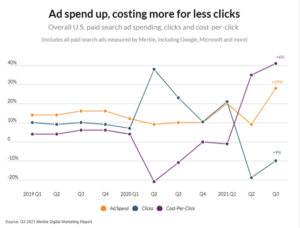Looking back at this past year, we can start planning to make 2022 the best one yet.
It’s fair to say that every year brings new trends, ideas, and lessons in the growth marketing space. But can we all agree that 2021 was truly one for the books? We saw so many changes packed into a single volume.
A few of the growth marketing trends our Chameleons noticed in 2021 were a bit jaw-dropping. Some we hope will end when we flip the calendar to a new year. Others show great promise, so we’re excited to see how they evolve in 2022.
Here’s a rapid-fire recap of growth marketing trends in 2021 and what you can do to prepare for 2022.
Digital Advertising Costs Get More Expensive and Less Effective
The ongoing rising costs of goods aren’t just limited to gas, groceries, and homes. Digital products have been affected, too—namely the cost of digital advertising CPCs (cost-per-click) and CPM (cost-per-thousand). A recent report found that digital cost-per-click jumped 41% year over year.
One potential reason points to the sudden shift to digital in the early days of the pandemic. Many aspects of our daily lives left the physical world in favor of remote technologies, from shopping to working to interacting with others. The pandemic still isn’t “over,” and companies continue to lean more heavily on digital channels than they did pre-pandemic.
Naturally, a greater demand for ad space drives up the costs for marketers. This isn’t affecting just one industry or sector, either. There’s another side to this same coin, and it’s no shinier than the first one. While prices are increasing, ad effectiveness is dwindling. That’s right—marketers are paying more money for less traffic and a lower return on investment.
And yet, what choice do they have? Their competitors are spending money on digital ads, and so they must, too.
Startups and direct-to-consumer brands are disproportionately affected by this shift. These are typically digital-native companies (think Warby Parker, Allbirds, etc.) that have enjoyed the lion’s share of the online consumer market for so long. This has made it easier for them to gain share of voice and carve unique niches in the market. But those days may be coming to a close, especially for startups and small D2C companies with lean budgets that usually rely on digital advertising ads to acquire new customers.
The good news is that we don’t expect a comparable dramatic rise in costs going forward. Advertising costs will likely continue to increase, just not at the levels we saw over the last year due to a large surge in demand post year one of the pandemic. In addition, with more people feeling confident about going into a store to shop for goods compared to last year, this could be a sign that consumer preferences are changing once again. It’s certainly worth noting as you develop your growth marketing strategy for 2022.
Digital Purchasing Continues to Rise
With rising costs comes a significant increase in demand, online shopping continues to grow. In fact, digital shopping revenue between November and December 2021 is expected to surpass $200 billion for the first time ever. Digital Commerce 360 reported that customers spent about $109 billion online from November 1 through 29 (a period that includes Cyber Week), nearly a 12% increase over last year’s numbers.
Last year saw a major shift in the types of items purchased online as well as the frequency in which shoppers placed online orders. Some of those habits still remain, especially as grocery stores and brick-and-mortar retailers continue to struggle to fill shelves. But as in-person shopping resurfaces and more conditions return to normal, the growth rate of digital purchasing may lessen.
Does this mean that online purchasing channels are in trouble? Highly doubtful. A slowdown in growth is still growth. More than likely, online shopping will hold steady.
Privacy Changes Impact the Marketing Landscape
As online services make changes to improve the security of sensitive customer information, it’s important to stay abreast of how these changes affect the way we do business in the marketing realm. A prime example of this phenomenon was the privacy-focused iOS 14 update from Apple, which disrupted the ability to keep track of conversion events on the Facebook app and online platform. This potentially prevents you from accurately analyzing your ad campaign’s performance and targeting ads to appropriate audiences using iOS 14.5 and above.
Another Apple update, iOS 15, created complications for email marketing campaigns. Customers using this operating system or higher and running Apple Mail can now opt out of email tracking, which can prevent you from determining a campaign’s open rates.
Careful due diligence and preparation can help you alleviate the impact of these changes on your marketing efforts. You must constantly strategize and be ready to iterate your approach to keep up with the never-ending evolution of online tools and channels.
For example, you might have heard about the transition away from tracking cookies taking place by the end of 2022. Google plans to phase out these long-used data bites in both the Chrome browser and online searches, so it will pay to start thinking about how your brand uses cookies now and research possible alternatives.
Strive for Solutions in 2022 and Beyond
As you’ve probably realized, you won’t be able to simply stick to the status quo to succeed in 2022. Consider adding these strategies to your toolkit as you prepare to accelerate your brand’s growth in the years to come:
- Invest in impactful creative. You need strong photos and video creative to get noticed in the era of social shopping scrolls.
- Diversify your channels. Find out where your audience really spends time online; it might not be where you expect. Don’t be afraid to dive into new platforms if you’re hungry for new prospects and conversions.
- Leverage your first party data to precisely target your advertising efforts and invest in a robust customer data platform to understand your consumer and customer lifetime value in relation to your customer acqusition costs.
- Explore predictive data. With artificial intelligence, marketers can increasingly understand which customers will make a future purchase and when. Knowing how this works can revolutionize your ability to convert.
- Don’t discount influencer marketing. Forbes says this avenue will grow far beyond its current peak of $13.8 billion next year.
- Engage with your audience through online events. Think virtual product launches, Q&A sessions, and webinars that show off your brand while connecting on a deeper level with potential clients.
What changes have you seen in the growth marketing space in 2021, and how are you preparing to use these evolutions in 2022?






